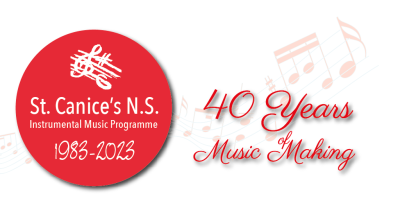The video shows Aideen Ryan 6th Class 2013-2014 interviewed and performing in Senior Orchestra in the programme “Meet The Orchestra” recorded in May 2013 and aired on RTE Junior in September 2013
The viola is slightly larger than the violin. Like the violin, sound is produced by the drawing the bow across one of the four strings or by plucking the string with a finger. All orchestra string instruments produce sound in the same manner. The main differences are the sizes of the instruments and how high or low each instrument can sound.
The viola comes in just two pieces, the instrument and the bow. The bow uses horsehair or a synthetic material to vibrate the strings as it is drawn over the strings. The viola is played with the instrument under the chin on the left side. The right hand holds the bow at the bottom (the bottom of the bow is called the “Frog”) and draws the bow over the strings.
The viola is a very old instrument. It has been basically unchanged for hundreds of years. The viola looks and sounds a lot like a violin. The difference has to do with size and pitch. Both instruments have four strings. The highest violin string is the E string. If you were to remove this highest string and add a new lowest string or C string, you would have a viola.
A unique feature of student violas is the huge variation in sizes. Buyers have the option of a 15, 14, 13 or 12 inch viola. The correct size for each student depends on the arm length and overall size of the student. Students are measured by our viola teachers to determine the correct size of instrument for them as individuals.
The viola is not nearly as popular as the violin. Because there are fewer violists, orchestra teachers consider a good viola player as a very valuable asset to the group.
St Canice’s violists perform in the Senior orchestra and the Junior orchestra and may also get together with fellow string, woodwind or brass players to form quartets or other smaller performing groups.
